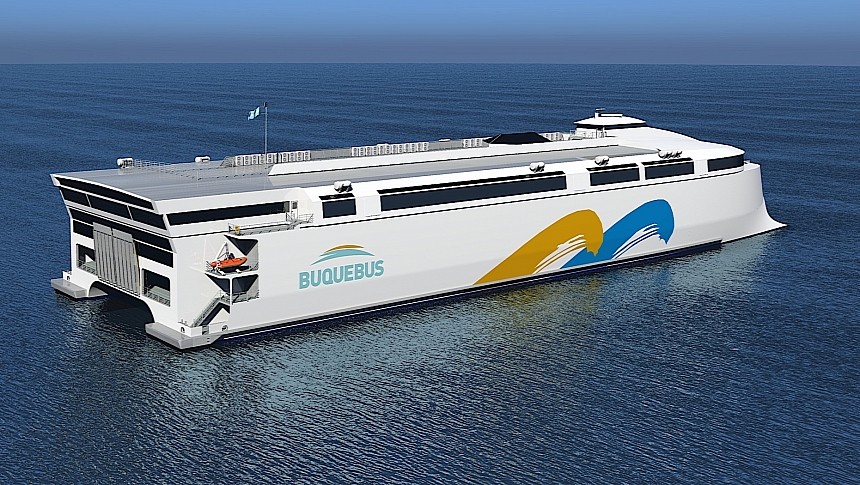The promises of electrification have long convinced the automotive industry to embrace this source of power for the cars and motorcycles now being rolled out. But they are so convincing, it seems, that they are slowly taking over other industries as well, including aviation and shipbuilding.
It's the latter we're interested in here, as what until recently seemed mostly theoretical – large ships powered by batteries and electric motors – is rapidly becoming a reality.
Helping with that is Australian shipbuilder Incat Tasmania, which for a while has been working on something it promises to be the largest lightweight battery-electric vessel ever made. A ferry by trade, it will serve the needs of Uruguayan company Buquebus starting sometime in 2025, when work on it will be over.
We've known many of the details that'll make the yet-unnamed vessel something to remember for a while now. For instance, it has a hull 130 meters (426 feet) long, and it will be capable of carrying 2,100 passengers and 225 vehicles on routes linking Argentina to Uruguay. The ship will have all the facilities expected from a ferry, including a duty-free shop with a surface area of 2,000 square meters (21,500 square feet).
Initially, Incat planned to make the ship run on liquefied natural gas (LNG), but decided to switch and went for a full electric drive system instead. And judging by what we learned about it now, it's impressive to say the least.
The thing will hide in its bowels a battery pack with a total storage capacity of 40 MWh. That's 40,000 kWh, or roughly the amount of energy an army of 487 Teslas are capable of holding combined. It's also a battery system "four times larger than any battery installation that has been constructed and installed anywhere in the world for the marine transport environment," as per Incat.
The energy stored here will be used to power electric motors that in turn drive the water jet propulsion. Initial details point to the ship being capable of reaching speeds of up to 29 mph (46 kph). Despite the huge storage capacity, the fact the ferry is expected to haul heavy loads impacts range a lot: it's expected it can travel some 115 miles (185 km) on a single charge.
With this latest update on the subject, so far known only as the Incat 096, the company also announced plans to make more such ships in the future, probably giving birth to a new class of vessels. The one to follow is also a ferry, a bit smaller than this one, but the details on that are scarce to say the least at the moment.
We have no info on the cost of this impressive ship, but we'll probably learn something about that closer to the official launch.
Helping with that is Australian shipbuilder Incat Tasmania, which for a while has been working on something it promises to be the largest lightweight battery-electric vessel ever made. A ferry by trade, it will serve the needs of Uruguayan company Buquebus starting sometime in 2025, when work on it will be over.
We've known many of the details that'll make the yet-unnamed vessel something to remember for a while now. For instance, it has a hull 130 meters (426 feet) long, and it will be capable of carrying 2,100 passengers and 225 vehicles on routes linking Argentina to Uruguay. The ship will have all the facilities expected from a ferry, including a duty-free shop with a surface area of 2,000 square meters (21,500 square feet).
Initially, Incat planned to make the ship run on liquefied natural gas (LNG), but decided to switch and went for a full electric drive system instead. And judging by what we learned about it now, it's impressive to say the least.
The thing will hide in its bowels a battery pack with a total storage capacity of 40 MWh. That's 40,000 kWh, or roughly the amount of energy an army of 487 Teslas are capable of holding combined. It's also a battery system "four times larger than any battery installation that has been constructed and installed anywhere in the world for the marine transport environment," as per Incat.
The energy stored here will be used to power electric motors that in turn drive the water jet propulsion. Initial details point to the ship being capable of reaching speeds of up to 29 mph (46 kph). Despite the huge storage capacity, the fact the ferry is expected to haul heavy loads impacts range a lot: it's expected it can travel some 115 miles (185 km) on a single charge.
With this latest update on the subject, so far known only as the Incat 096, the company also announced plans to make more such ships in the future, probably giving birth to a new class of vessels. The one to follow is also a ferry, a bit smaller than this one, but the details on that are scarce to say the least at the moment.
We have no info on the cost of this impressive ship, but we'll probably learn something about that closer to the official launch.








